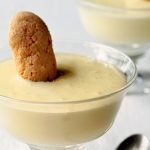 English has two names for the foamy dessert made by whisking together egg yolks, Marsala wine, and sugar: zabaglione and sabayon, both deriving from the same source but entering English via different routes. The common source of the words is probably the Latin sabaia, the name of a drink that originated along the eastern coast of the Adriatic Sea. In Italian, sabaia became zabaglione, the ione ending of the Italian word being an augmentative suffix that causes the word to mean big sabaia; English adopted this name of the dessert at the end of the nineteenth century. French, however, also adopted this Italian name, changing it to sabayon in the process; in the early twentieth century, English adopted this French name as well, and the two terms—sabayon and zabaglione—have existed side by side ever since.
English has two names for the foamy dessert made by whisking together egg yolks, Marsala wine, and sugar: zabaglione and sabayon, both deriving from the same source but entering English via different routes. The common source of the words is probably the Latin sabaia, the name of a drink that originated along the eastern coast of the Adriatic Sea. In Italian, sabaia became zabaglione, the ione ending of the Italian word being an augmentative suffix that causes the word to mean big sabaia; English adopted this name of the dessert at the end of the nineteenth century. French, however, also adopted this Italian name, changing it to sabayon in the process; in the early twentieth century, English adopted this French name as well, and the two terms—sabayon and zabaglione—have existed side by side ever since.
The given text pertains to a type of dessert preparation, which comprises a blend of egg yolks, sugar, Marsala, and cinnamon. This mixture is beaten until it reaches a thick consistency while being heated over boiling water in the top portion of a double boiler. The dessert is served either hot in its liquid state or chilled until it attains a semi-solid texture. It is important to note that this dessert may be spelled as zabaione.
Hailing from Italy, there exists a delectable confection known as zabaglione. This indulgent treat is a velvety amalgamation of wine, typically Marsala, blended with egg yolks and sugar. Through a delicate application of heat, the mixture is vigorously beaten until it reaches a sumptuous thickness. Served in warmed glasses, zabaglione is a delightful dessert that tantalizes the taste buds. It is worth noting that sabayon sauce, a delectable variant, shares its roots with zabaglione, offering a captivating twist to this culinary delight.
